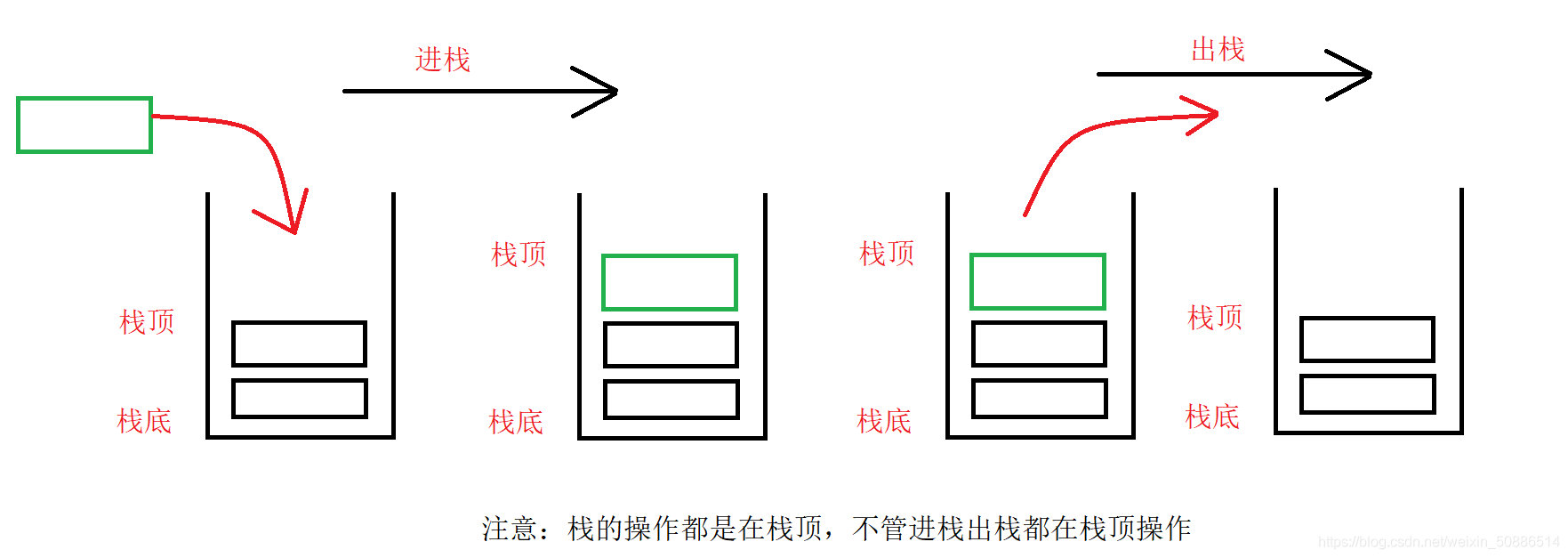Inhaltsverzeichnis:
1. Einführung in den Stack
1. Die Definition des Stapels
Stapel : Eine spezielle lineare Tabelle, die nur das Einfügen und Löschen von Elementen an einem festen Ende ermöglicht. Ein Ende der Dateneinfüge- und Löschvorgänge wird als oberes Ende des Stapels und das andere Ende als unteres Ende des Stapels bezeichnet . Die Datenelemente im Stapel entsprechen dem LIFO- Prinzip (Last In First Out)
• Push : Der Einfügevorgang des Stapels wird als Push / Push bezeichnet , und die Daten werden oben auf den Stapel gelegt.
• Pop : Der Löschvorgang des Stapels wird als Pop bezeichnet. Die Ausgabedaten befinden sich ebenfalls oben im Stapel.

2. Schematische Darstellung der Stack- und Pop-Struktur
Arrayform:

Kettenstruktur:

Entsprechend der Abbildung werden beide Operationen oben ausgeführt
3. Implementierung des Stacks (Array wird empfohlen)
(1) Stack.h-Stack-Management und -Schnittstelle
#pragma once
#include<stdio.h>
#include<stdlib.h>
#include<assert.h>
typedef int STDataType;
typedef struct Stack
{
STDataType* a;//动态数组
int top; //栈顶
int capacity; //容量
}Stack;
//初始化栈
void StackInit(Stack* pst);
//销毁栈
void StackDestroy(Stack* pst);
//入栈
void StackPush(Stack* pst, STDataType data);
//出栈
void StackPop(Stack* pst);
//获取栈中有效元素的个数
int StackSize(Stack* pst);
//获取栈顶元素
STDataType StackTop(Stack* pst);
//检测栈是否为空,为空返回1,非空返回0
int StackEmpty(Stack* pst);
(2) Die Realisierung jeder Schnittstellenfunktion des Stack.c-Stacks
#include"Stack.h"
//初始化栈
void StackInit(Stack* pst)
{
assert(pst);
pst->a = (STDataType*)malloc(sizeof(STDataType)* 4);
if (pst->a == NULL)
{
printf("malloc fail");
}
pst->top = 0;
pst->capacity = 4;
}
//销毁栈
void StackDestroy(Stack* pst)
{
assert(pst);
free(pst->a);
pst->a = NULL;
pst->top = 0;
pst->capacity = 0;
}
//入栈
void StackPush(Stack* pst, STDataType data)
{
assert(pst);
//空间不够需要增容
if (pst->top == pst->capacity)
{
//增容为原来的2倍
int* tem = (STDataType*)realloc(pst->a, sizeof(STDataType)* pst->capacity * 2);
if (tem == NULL)
{
printf("realloc fail");
exit(-1);
}
pst->a = tem;
pst->capacity = pst->capacity * 2;
}
pst->a[pst->top] = data;
pst->top++;
}
//出栈
void StackPop(Stack* pst)
{
assert(pst);
//判断栈是否为空
//相当于assert(pst->top != 0);
assert(!StackEmpty(pst));
pst->top--;
}
//获取栈中有效元素的个数
int StackSize(Stack* pst)
{
assert(pst);
//因为初始化top是0,如果初始化top是-1则返回top+1;
return pst->top;
}
//获取栈顶元素
STDataType StackTop(Stack* pst)
{
assert(pst);
assert(!StackEmpty(pst));
return pst->a[pst->top - 1];
}
//检测栈是否为空,为空返回1,非空返回0
int StackEmpty(Stack* pst)
{
assert(pst);
return pst->top == 0 ? 1 : 0;
}
(3) test.c test
#include"Stack.h"
void test()
{
//定义一个栈
Stack st;
StackInit(&st);
StackPush(&st, 1);
StackPush(&st, 2);
StackPush(&st, 3);
StackPush(&st, 4);
while (!StackEmpty(&st))
{
//取一个删一个
printf("%d ", StackTop(&st));
StackPop(&st);
}
StackDestroy(&st);
printf("\n");
}
int main()
{
test();
return 0;
}

2. Einführung in die Warteschlange
1. Definition der Warteschlange
Warteschlange : Eine spezielle lineare Tabelle, die nur das Einfügen von Daten an einem Ende und das Löschen von Daten am anderen Ende ermöglicht . Die Warteschlange folgt dem FIFO-Prinzip (First In First Out).
• In der Warteschlange : Das Ende der Einfügeoperation wird als Ende der Warteschlange bezeichnet.
• Außerhalb der Warteschlange : Das Ende der Löschoperation wird als Kopf der Warteschlange bezeichnet

2. Implementierung der Warteschlange (empfohlen, eine verknüpfte Liste zu verwenden)
(1) Warteschlangenverwaltung und -schnittstelle Queue.h
#pragma once
#include<stdio.h>
#include<assert.h>
#include<stdlib.h>
typedef int QDatatype;
//链式结构:表示队列
typedef struct QueueNode
{
QDatatype data;
//指向下一个节点的指针
struct QueueNode* next;
}QueueNode;
//队列的结构
typedef struct Queue
{
QueueNode* front;//头指针
QueueNode* tail;//尾指针
}Queue;
//初始化队列
void QueueInit(Queue* pq);
//销毁队列
void QueueDestroy(Queue* pq);
//队尾入队列
void QueuePush(Queue* pq, QDatatype x);
//队头出队列
void QueuePop(Queue* pq);
//检测队列是否为空,为空返回1,非空返回0
int QueueEmpty(Queue* pq);
//获取队列中有效元素的个数
int QueueSize(Queue* pq);
//获取队列头部元素
QDatatype QueueFront(Queue* pq);
//获取队列队尾元素
QDatatype QueueBack(Queue* pq);
(2) Queue.c-Implementierung der verschiedenen Schnittstellenfunktionen der Warteschlange
#include"Queue.h"
//初始化队列
void QueueInit(Queue* pq)
{
assert(pq);
pq->front = pq->tail = NULL;
}
//销毁队列
void QueueDestroy(Queue* pq)
{
assert(pq);
QueueNode* cur = pq->front;
while (cur)
{
QueueNode* Next = cur->next;
free(cur);
cur = Next;
}
pq->front = pq->tail = NULL;
}
//队尾入队列
void QueuePush(Queue* pq, QDatatype x)
{
assert(pq);
QueueNode* newnode = (QueueNode*)malloc(sizeof(QueueNode));
newnode->data = x;
newnode->next = NULL;
if (pq->tail == NULL)
{
pq->front = pq->tail = newnode;
}
else
{
pq->tail->next = newnode;
pq->tail = newnode;
}
}
//队头出队列
void QueuePop(Queue* pq)
{
assert(pq);
//队列不能为空
assert(!QueueEmpty(pq));
//如果只有一个节点,防止tail野指针
if (pq->front == pq->tail)
{
free(pq->front);
pq->front = pq->tail = NULL;
}
//多个节点
else
{
QueueNode* Next = pq->front->next;
free(pq->front);
pq->front = Next;
}
}
//检测队列是否为空,为空返回1,非空返回0
int QueueEmpty(Queue* pq)
{
assert(pq);
return pq->front == NULL ? 1 : 0;
}
//获取队列中有效元素的个数
int QueueSize(Queue* pq)
{
assert(pq);
int count = 0;
QueueNode* cur = pq->front;
while (cur)
{
++count;
cur = cur->next;
}
return count;
}
//获取队列头部元素
QDatatype QueueFront(Queue* pq)
{
assert(pq);
assert(!QueueEmpty(pq));
return pq->front->data;
}
//获取队列队尾元素
QDatatype QueueBack(Queue* pq)
{
assert(pq);
assert(!QueueEmpty(pq));
return pq->tail->data;
}
(3) test.c test
#include"Queue.h"
void TestQueue()
{
Queue q;
QueueInit(&q);
QueuePush(&q, 1);
QueuePush(&q, 2);
QueuePush(&q, 3);
QueuePush(&q, 4);
while (!QueueEmpty(&q))
{
printf("%d ", QueueFront(&q));
QueuePop(&q);
}
printf("\n");
QueueDestroy(&q);
}
int main()
{
TestQueue();
return 0;
}
